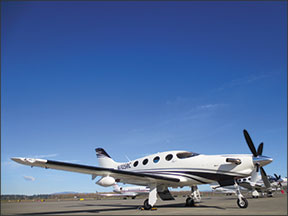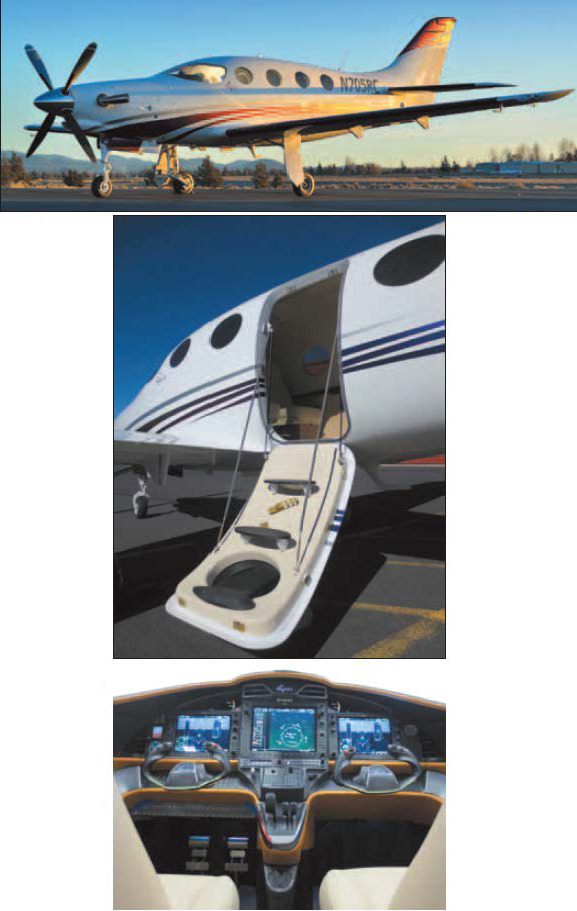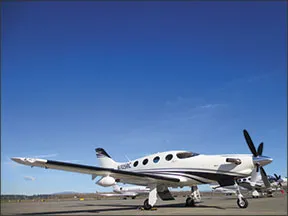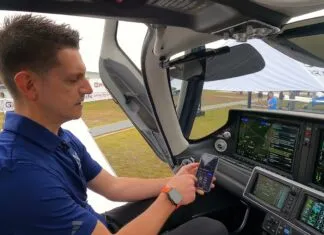To date, the single-engine turboprop market has been a classic economic model of independent niches—the players don’t compete directly. The Pilatus PC-12, Daher-Socata TBMs, Cessna Caravans, Quest Kodiak and Piper Meridian target different mission and load needs; there’s not much to encourage price competition, although the TBMs are so fast they do go head to head with some jets.

This could change in 18 months—when Epic Aviation hopes to finish certification and start delivery of its 1200-HP E1000 to compete directly with the new TBM 900. Epic offers an amazingly slippery-looking, hell-for-stout carbon-fiber machine with a larger cabin, more payload, max cruise speed within measurement error and slightly shorter legs than the TBM.
With an initial $2.75 million price tag for the E1000—we wonder if Socata will drop its $3.4 million-equipped price to compete. To make it more interesting, the FAR Part 23 certificated airplane Epic is developing started life as an Experimental category, kitbuilt aircraft.
History
In 2004, Epic Aircraft began selling the LT, a 320-knot, composite, single-engine turboprop, as a kit. Buyers would spend several weeks at Epic’s facility, working under supervision, as they complied with the 51 percent owner-built rules for the basic airplane. Once past that hurdle, they were free to contract with Epic for the company to build the rest of the airplane and add on various options.
In 2009, a combination of management shenanigans forced Epic Aircraft into bankruptcy. It was sold at auction in 2010. The new owners started selling kits again. In 2012, the company was again sold, this time to Engineering, L.L.C., a Russian company. It appears to be well-financed and has announced its determination to build a certificated airplane based on the LT—the E1000. Putting skin in the game, the new Epic Aircraft also purchased the old Lancair Columbia/Cessna Corvalis factory on the Bend, Oregon, airport. During our visit to the 200,000 square-foot facility, we saw the last few LT kit-built airplanes being finished up in one building while work was going forward on the molds to build conforming parts for the E1000 in another.

Epic has forecast FAA Part 23 certification of the E1000 in 2015; given all that goes into that process and its requirement for the regular infusion of cubic money—we think there’s a pretty good chance it will happen if world sanctions imposed on Russia for its behavior in the Crimea don’t shut off the tap. Epic has been hiring engineers and has built and tested some parts of what are to be the conforming prototype airplanes (two are planned and are to be completed this year).
No Changes
We were told that Epic management decreed that the E1000 would simply be a production version of the LT—there were to be minimal changes to the airplane. While that approach sounds good and is intended to keep costs down, the reality is never that simple. Although, having what might be considered to be over 50 “proof of concept” airplanes providing feedback from the field doesn’t hurt.
Nevertheless, there will have to be some expensive changes. For example: The seats will have to meet crashworthiness requirements—that’s a million bucks just getting the first ones designed and built. Max stall speed under Part 23 is 61 knots, the LT we flew stalled at 63, even with its long, double-slotted flaps. A stall speed above 61 knots generates changes in crashworthiness requirements that can be prohibitively expensive and heavy. We were told VGs are being considered to reduce stall speed and that a stick pusher system may be installed as well.
Because no production-conforming prototype E1000 exists, we flew two different Epic LTs, one only recently completed and one from the middle of serial number range. We were satisfied from our meeting with chief pilot Rich Finley and VP of marketing, Mike Schrader, that the production airplane will have handling and performance at least on a par with the LT. Because handling, stability and control for the LT are close to what will be required for certification, one we flew had weights installed for flight tests for aft CG handling.
Airframe
The LT is, and the E1000 will be, constructed of carbon fiber—at the high end of the spectrum of strength-to-weight ratios of composites. The wing is a one-piece unit that has been tested to over 10G, as has, we were told, the conforming ailerons. On one hand, building to such a load factor means the structure is too heavy, especially given the very conservative FARs on composite structure strength. However, it also gives a great deal of room for the airplane to grow.
The fit and finish of the LTs we looked at was first rate—one of the benefits of composites. The absolutely smooth, clean skin is formed into a number of compound curves that help with both high- and low-speed performance and would be unreasonably expensive to attempt on a metal airplane. The windshield appears to simply be a transparent section of the overall airframe, so smoothly is it faired. The wing leading edge has an unusual curved taper—we learned it was purely for esthetics, not performance. We were a little surprised at the modest size and shape of the winglets and can’t help but wonder if they will be tweaked in the future as Pilatus has now done a few times on the PC-12.
Power
The engine is a Pratt & Whitney PT-6-67A with a 1825-ESHP thermodynamic limit, derated to 1200 SHP. TBO is 3500 hours. It swings a four-blade prop; we couldn’t help but wonder if a five-blade isn’t somewhere on the drawing board, although with a 4000-FPM initial rate of climb, the extra weight may not be worth any incremental performance gain.
The dual buss electrical system is powered by a starter/generator and backup alternator—outputs to be defined. There will be two batteries, mounted on the firewall. The hydraulic landing gear has an emergency nitrogen blow-down backup. A total of 288 gallons of fuel can be carried in the two tanks—a maximum of 400 pounds of fuel imbalance is acceptable. It is anticipated that a device to automatically switch tanks will be installed—the LT requires that it be done manually. Max pressurization differential is 6.5 PSI.
De-icing will be provided by leading edge boots. Known icing certification will probably require some form of windshield anti- or de-icing. We were told that the windscreen is so highly raked that simply using defrost has been adequate per owners in the field. Schrader and Finley said that bleed air will probably be used.
Weight
Gross weight is to be 7500 pounds, with an empty weight of 4400 pounds targeted—Epic wants a full-fuel payload of over 1100 pounds so it can be a fill the seats and fill the tanks machine, besting the TBM by more than 300 pounds. The reality of certification usually means empty weight creep; we’ll be watching to see how effective Epic’s engineers fight that battle.
Inside
The cabin door is aft of the wing, just ahead of the rear seats. There are two seats in the cockpit, and four in the cabin. There is space for baggage behind the rear seats. Currently 500 pounds is allowed.


